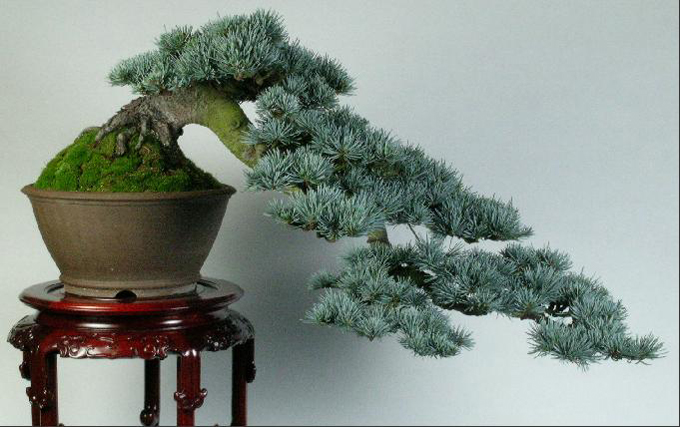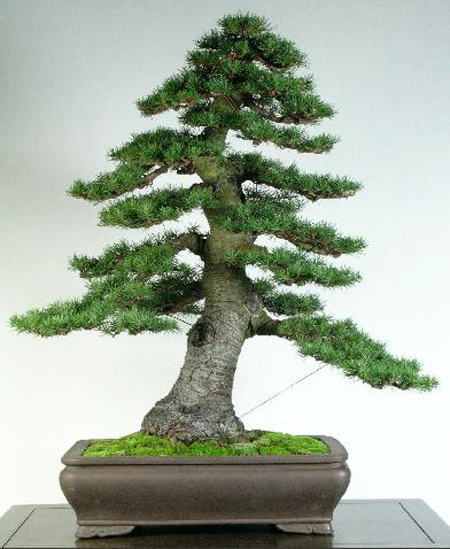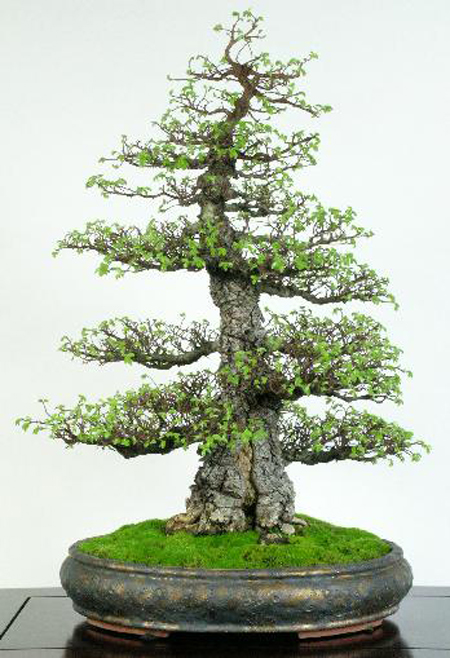 Jim Gremel had a Blue Atlas Cedar (Cedrus atlantica – one of the handful of true Cedars) at the 2012 U.S. National Bonsai Exhibition that looked a lot like this one.
Jim Gremel had a Blue Atlas Cedar (Cedrus atlantica – one of the handful of true Cedars) at the 2012 U.S. National Bonsai Exhibition that looked a lot like this one.
Deer Meadow Bonsai & the 3rd U.S. National Bonsai Exhibition
Some of the trees that were offered for sale at the 3rd National were every bit as good as some of the trees in the display area.
One of my favorite vendors at the show was Jim Gremel (Deer Meadow Bonsai). Not only did Jim go to the trouble of coming all the way from Northern California, but he was a close neighbor of mine in the vendor section (I don’t usually write much about personality in this blog, but there’s something about Jim’s straightforward manner and sense of humor that I liked).
I was also impressed with Jim’s trees, including one that looked a lot like the one above (was it the same tree?). He didn’t bring many, but traffic around his display was strong throughout the show and he left with a lot fewer than he brought (I wasn’t going to mention the popularity of his annealed copper bonsai wire because we are now offering annealed copper wire, but there’s plenty of room in our bonsai world and it provides an opportunity to sneak in a link, so why not?)
Now, if we can find some good photos of Suthin’s trees…
 This classic beauty is a Green Atlas Cedar. I’m not sure why some are green and some are blue, but my best guess is that the blue ones are cultivars.
This classic beauty is a Green Atlas Cedar. I’m not sure why some are green and some are blue, but my best guess is that the blue ones are cultivars.
 Even though this Cork Elm is a deciduous tree that is shaped like a conifer (there really are no laws, other than nature’s tendencies, that say you can’t do this, however, Robert Steven might have something to say about it), the gnarly old trunk, with its perfect taper, grabbed my attention (like the others shown here, it’s on Jim’s website).
Even though this Cork Elm is a deciduous tree that is shaped like a conifer (there really are no laws, other than nature’s tendencies, that say you can’t do this, however, Robert Steven might have something to say about it), the gnarly old trunk, with its perfect taper, grabbed my attention (like the others shown here, it’s on Jim’s website).
Wayne,
The blue version of the Atlas Cedar is Cedrus Atlantica ‘Glauca’, as opposed to the green which is the ‘base’ version Cedrus Atlantica. Cheers, Joe
Hi, Wayne! I can see you are well and working. Great posts. May I translate your post, with Steven comments, about shaping deciduous trees like a conifers? I plan to post it in my blog. Many brazilian bonsai lovers do not speak english. Of course I intend to inform the source of the original text. Thanks, regards from Brazil.
I too like Robert have a tendency to look at the elm and shake my head wondering why. It is well cared for and styled nicely but without the mechanical manipulation by man the elm would never in a million years grow like this in nature. I like this tree though even though its styled like a conifer it breaks the norm-it is unique. I bet there’s not many elms out there this nice in the formal upright style. It really goes to show that it doesn’t matter what I ,you or Robert Steven think or say about a tree- what matters is does it make the owner happy?
PS- I think Robert Steven is a Bonsai genius
Thanks Joseph,
Yeah. Glauca. I’m not sure why I failed to mention that. It’s a name commonly attached to cultivars that are bluish-greyish.
Hi Marcelo,
Thanks for your kind words.
And yes, of course. Translate to your heart’s content. It’s always good to know that some people bother to read my posts in English, let alone Portuguese.
Hi Steven,
Yes, agreed, it’s a very compelling tree.
It has long been my contention that bonsai rules and guidelines, including those based on nature, can be very useful, but ultimately, if we regard bonsai as an art, we need to keep our minds open and be willing to accept variation from norms.
And yes, agreed about Robert also. His breath and dept of knowledge is over the top. And his bonsai, as well as his simulations and his writing, express that breath and depth.
Hi Wayne
The Atlas cedars are the “true” cedars. There several kinds coming from the so Europe/ no Africa areas. The atlas cedar has a few varieties and within those varieties there are “weeping” cultivars and other variants.
The Blue Atlas is a variety of Atlas cedar that comes from the Atlas mountain ranges of Morroco. There is a whole mountain range made up of Blues cedars, the Glauca variety. It is actualy a big tourist attraction in Morroco to vidit the Blue forrest’s. I’m sure any google search will yield you many pics of giant blue trees.
Here, in So. California, many types of Cedars are common in the landscape of our neighborhoods with the Deodar Cedar being most popular, but the Blue Glauca’s can be seen growing all over town and realy stand out!
Recently, I was at Jim Gremel’s deer meadow bonsai in no. California. I was speechless at the beauty if his trees!
If you love bonsai, a visit to his place needs a prominent spot on your bucket list.
Elliott Farkas
Hi Elliot,
Thanks for the clarification on the Atlas cedars.
I’ve notice in my wanderings that some people think that the Atlas cedar and Cedar of Lebanon are actually the same species. If this is the case, then I believe there are only two true cedars in the world, The other being your Deodar. Either way, two or three, that’s not many. Especially considering that so many non-cedars are commonly called cedars.